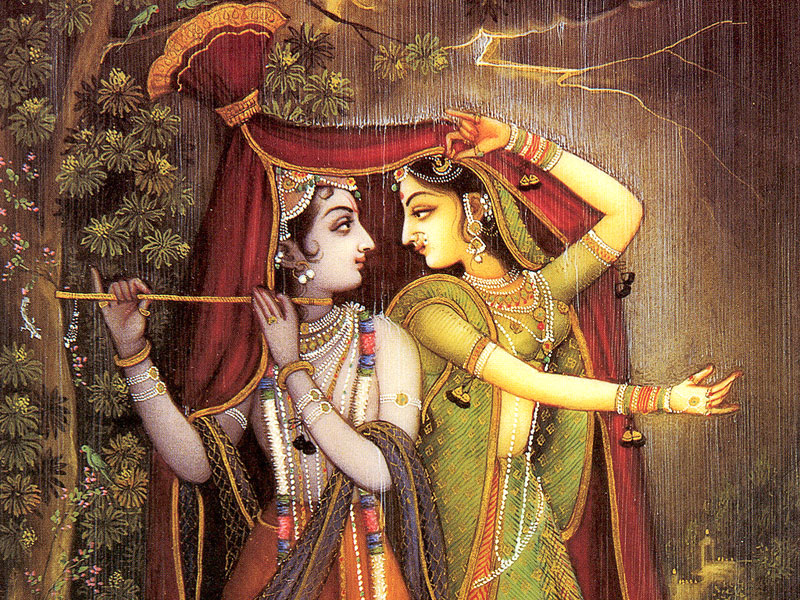This is a summary of a discourse on the significance of Purushottama-month, by His Divine Grace Srila Bhakti Ballabh Tirtha Goswami Maharaj, President-Acharya of Sree Chaitanya Gaudiya Math.
vande navaghana-syam dvibhujam murlidharam
pitambardharam devam saradham purusottamam
"I offer my obeisances to Navaganasyam (Krsna, who has the color of a fresh rain cloud), who is holding the flute with His two hands. I worship Purusottama who is so beautiful in His yellow dress (pitambhara)."
I pray for the causeless mercy of my Gurudeva, His Divine Grace Srila Bhakti Dayita Madhava Gosvami, to give me strength, to sing the glories of the Supreme Lord Sri Krsna and His personal associates, to purify my mind and to get exclusive one-pointed devotion to the Supreme Lord Sri Krsna. I pay my innumerable prostrated obeisances to my most revered siksa gurus and I pay my due respects to all who are present here.
By the will of the Supreme Lord we have come back to India during this month of Purusottama, which is actually the holiest month.
According to our almanac every three years, one month is added. This is done to harmonize the lunar month (Chandra-maas) with the solar month (Soar Maas). The inserted month is known as 'Purusottama', and is technically called an 'intercalary month'. According to some smarta Brahmins, this month is unholy. They call it 'tarnished'.
Prescribing various holy functions for all months of the year, they left out this additional month taking it to be unholy ('tarnished') for no holy activity can be performed therein.
Yet Vaishnava devotees object to this, arguing that not a single moment is to be spent without the worship of the Supreme Lord. If you spent it to the contrary, your life will be spoiled. If we shall not do any holy work in this month, then if we will die in this month we shall go to hell? This is not the purpose. But these karma-kandis, who prescribed these rituals and regulations were inclined to observe them merely for achieving material benefits in this world and being uplifted after death to heaven. Taking this to be the aim and not being able to understand the purpose behind it, they encourage the observance of rules and rituals. So, they neglected this month.
As everything has got consciousness in the background — the example is given of the sun, which is presided over by the Sun god, the moon which is presided over by the Moon god and Srimati Ganga Devi, who is the presiding Deity of the river Ganges — so similarly this month has a presiding deity.
Being depressed due to her seemingly useless existence, the personified deity of this month approached Lord Narayana. This incident is described in the scriptures. She went to Narayana, asking, 'What offense did I commit? No one is performing any pious activities during my time. Why?' Lord Narayana directed her towards Lord Krsna: 'You come with Me, I shall take you to Lord Krsna.' Upon being approached by her, Lord Krsna responded: 'I am Purusottama and I can not be comprehended by finite beings of this world. They can not comprehend Me by their mental comprehension and sense organs as I am beyond these means.' Those Brahmins also are under the control of the illusory energy. They give some prescriptions for getting mundane benefits without understanding that these various prescriptions simply have been given to facilitate different classes of persons to finally submit to the Supreme Lord. Yet the purpose is not the achievement of material benefits, but it is to recover from the disease of birth and death and to finally develop loving devotion to the Supreme Lord, and thus experience supreme bliss. They do not understand this.
Krsna explained: 'This additional month is like Me. I can not be comprehended by the conditioned souls of this world and I am supremely superior to Brahman and Paramatma so I am designated as "Purushottama." You are identical with Me. You are the holiest month. If anybody observes vrata (vow of austerity) during your time, he can get everything. If as by scriptural injunctions he observes it, it is even more auspicious than Kartik-vrata, the holiest month. So you will be known by the name "Purusottama".'
Vaisnavas do observe this Purusottama-vrata
This year Purushottama month is being observed from 17th May to 15th June. (Things to do:) We shall read the glories of Purushottama-Vrata, from the writings of Sri Bhakti Vinode Thakur, in the morning; daily recite 'Sri Jagannathastakam' and 'Chauragraganya Purusashtakamas' in the afternoon and perform Japam instructed by Kaundinya Muni:-
Goverdhana-Dharam Vande Gopalam Goparupinam,
Gokulotsavameeshaanam Govindam Gopikapriyam.
Then in the evening – Deep-dan (to offer a lamp of pure ghee) before Vishnu-Mandir (a temple of Lord Vishnu, Krishna or Rama), Lastly, at night to read 'Brahmastava' 40 slokas, from Srimad Bhagwattam, Chapter 14th, Canto 10th.
But as by the eligibility of those who perform it Srila Bhaktivinoda Thakura has given three categories, known as: 'Svanistha' 'Parinistitha' and 'Nirapeksa.'
Svanistha
Svanistha refers to those persons who have inclinations with Varnasrama-dharma and are still striving for material temporary benefits.
Being covered by the illusory potency — sattva, raja and tama guna they nevertheless follow some rituals. Prescriptions on how to perform this vrata are given by Valmiki Muni. Yet, hearing them may make you faint. They are very strict, like lying down only on a bed of nails rather than on a normal bed.
Parinistitha
Another section, superior in quality yet less in number is called Parinistitha. Parinistitha refers to those who are not striving for any material benefits and are correctly following the prescriptions as given by the respective acaryas of one of the four Vaisnava schools on how to observe this Purusottama-vrata (in a similar way as Kartika-vrata).
Nirapeksa
The highest form of observance is called Nirapeksa. Nirapeksa refers to those possessing one-pointed devotion to Sri Krsna. They concentrate on worshipping the Supreme Lord by hearing, chanting and remembering the name, form, pastimes and qualities of Sri Krsna day and night for spiritual benefit only. Reasoning correctly that any tendency for material benefit will certainly divert their minds, they observe this vrata by hearing about Krsna, chanting the Maha Mantra and taking prasadam. Srila Bhaktivinoda Thakura recommends we follow this path."
The daily month long program includes discourse with a brief kirtan followed by a lecture on Upadeshamrita, then a recitation of Sri Jagannathashtakam and Sri Chauragraganya-purushastakam. At the end, all will join to do silent Japa of the recommended sloka – Goverdhana Dharam vande Gopalam Goparupinam, Gokulotsav mishanam Govindam Gopikapriyam.
Just after the Japa, kirtan starts and Deep-daan is offered in front of the temple of Sri Sri Radha Nayananath (Established by the Founder-Acharya – Nitya lila Pravishtha Srila Bhakti Dayita Madhav Goswami Maharaj).
After an hour, the evening Arti – Jai Jai Gora Chander -starts, followed by Mandir Parikrama led by Srila B. B. Tirtha Maharaj.
In the next discourse at 8 P.M. there is the daily recitation and commentary of the Brahma-stava, Bhagvatam, Canto 10th, Chapter 14th.
This is part of the Vrata rules to read or hear the Brahma-stava.
Here in Calcutta Math, the presence of Srila Gurumaharaj is making devotees ecstatic! The weather is pleasant. It rains in the evening almost everyday.
Purushottam is the most congenial month for the bhakti-sadhan. The best feature being that even the aparadhas can be pardoned if we do devotional practice in this month. After every 32 months (Indian panchang) we have this Purushottam Maas (month) to adjust the difference between the solar and lunar calandars.
The Adhishthata of this holiest of all months is Sri Purushottam (Sri Krishna) Himself. So, of all the months, this month is the most favourite of the Supreme Lord Sri Krishna. The sadhana performed in this month will have manifold result.
Thakur Bhakti Vinode has described the glories and commandments of the Purushottam Maas in detail.
The Lord of the Universe – Sri Jagannath Dev is also known as Purushottam. Sree Chaitanya Mahaprabhu used to sing Sri Jagannath-ashtakam in Puri. So, we also recite the same Sri Jagannath-ashtakam in Purushottam Maas. Also we recite Sri Choragraganaya-Purushastakam daily in this month.
Submitted by Rasabihari das, Secretary, GOKUL (India)











